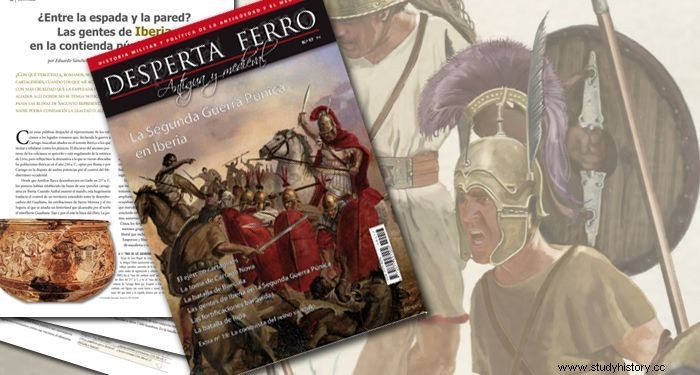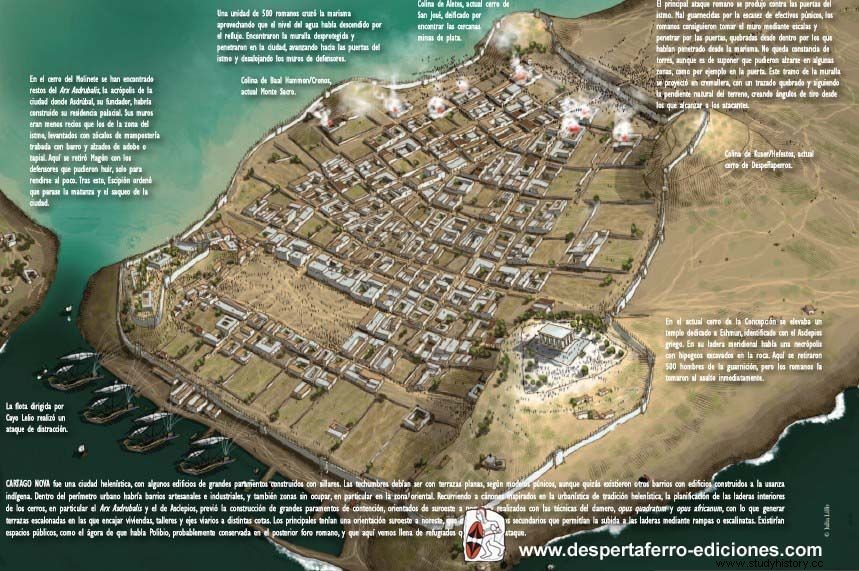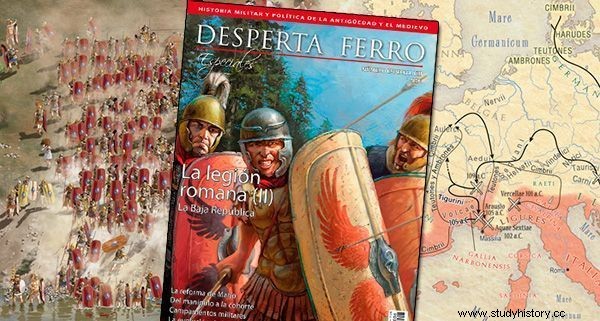The starting day was August 3, 2015, with the departure from Amposta, where the Nova Classis camp was located. Arrival in Cartagena, on August 17.
And what better way to get to know this company in depth than an interview with Eduard Ble, Albit Espuña, José Miguel Gallego, Javier García, Pau Menéndez, Alberto Pastor, Victor Bridge and Pau Valdés , creators of the VIA SCIPIONIS project.
1.During the Second Punic War, the Iberian Peninsula became a fundamental scene of the conflict, and one of its main milestones was the taking by General Scipio, in the year 209 a. C., from the city of Carthago Nova (current Cartagena), which until then had been the head of the Carthaginian effort in the peninsula. Its conquest was a great setback for Carthage and facilitated the expulsion of the Punics from Hispania. The VIA SCIPIONIS project aims to reconstruct the itinerary followed by Scipio on his way from Tarraco (Tarragona), then a Roman military base, to Carthago Nova, to lay siege to it. How and from whom did the initiative come about and what institutional or private support does the project have?
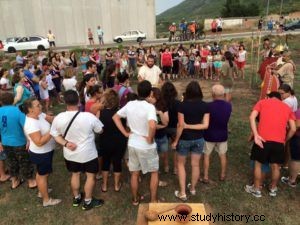
The VIA SCIPIONIS It is a proposal that was originally conceived by the private company ARTIFEX, conservation and recreation of archaeological heritage . The idea was to commemorate this historical episode that occurred during the Second Punic War from a totally innovative point of view, bringing together a scientific discipline, entertainment, quality cultural tourism and the dissemination of History. It was designed throughout the year 2013 to be developed during 2014 with the academic and institutional support of the Autonomous University of Madrid through its Experimental Archeology Laboratory directed by Professor Javier Baena, from the Spanish Association of Experimental Archaeology, Experiment , directed by Mr. Rodrigo Alonso and from the international network of open-air museums, EXARC based in the Netherlands. Unfortunately, the first attempt at financing, through crowdfunding (or micro-patronage), did not continue, as it could not exceed 35% of the total. That edition also intended to carry out a collection for social purposes, since part of the income had to go to the NGO Educo and its "scholarships-dining room" program.
Subsequently, given the difficulties in receiving public support and funding from the city councils of the municipalities through which the itinerary passed, it was decided to develop the project and its execution with private funds . The intention was to highlight the potential of the proposal, arouse the interest of the public administrations that had initially ignored it, and encourage them to support the project financially. Thus, the VIA SCIPIONIS it was finally carried out by eight volunteers, the equivalent of the minimum unit of the republican legion (the contubernium ), among whom were archaeologists, historians, students and amateurs. Luckily, we have the decisive collaboration of the historical re-enactment groups Evocati Apri Scipioni and Ibercalafell , who selflessly donated part of their equipment, and the support of the private company LA SUBURA , which defrayed a good part of the expenses derived from the transport. All this, to develop an itinerant experimental archeology and historical recreation event that lasted between the 3rd and the 17th of last August between the towns of Amposta and Cartagena.
2.The distance between the two points is about 480 km, and the historians Polybius and Titus Livy state that the march lasted seven days (Pol. X.9.7; Liv.XXVI.42.6). But this has traditionally been the subject of controversy, with some considering that figure to be spurious or exaggerated, considering it impossible to carry out the transfer of an army over such a long distance in such a short time. Is the confirmation or refutation of this story one of the objectives of the project? And, if so, what conclusion have you reached?
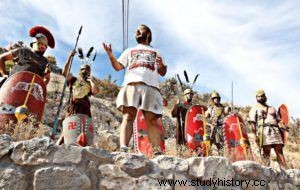
Unlike the historical episode, the proposal of the VIA SCIPIONIS He did not intend to match the feat but simply study the Republican legions on the march. For this reason, the sections were divided into distances that could be assumed daily without reaching the critical exhaustion of the participants, giving rise to a total of 15 stages. Some camping points inspired by the distances that are calculated as plausible for an army of that nature on the march were determined. Taking Amposta as a starting point, the towns of Traiguera, Coves de Vinromà, Borriol, Nules, Sagunto, Valencia, Algemesí, Xàtiva, Moixent, Caudete, Elda, Elche, Rojales, Pilar de la Horadada and finally Cartagena followed. Specifically, the volunteers walked a daily average of about 30 km, with some stages exceeding 36 km. that they had to travel with historical footwear and equipment with temperatures that some days rose above 40ºC.
Having said this, it is inevitable that the experience of this march in our own flesh (and feet) has formed an opinion regarding the credibility of the famous mention of the "seven days ” of the classical authors. It is true that this rhythm would imply that those men traveled an average daily distance of about 60 km, and as many authors have pointed out, it would be an athletic feat worthy of Hercules himself, which even impressed contemporaries. However, we consider that it is still a plausible process, taking into account that it was an exceptional event. In addition, we must not forget the logistical support that the army received from the fleet commanded by Cayo Lelio, which sailed parallel to the land advance, prepared to supply the ground troops with supplies or facilitate their evacuation in the event of an enemy attack. His presence would have made it possible to lighten the equipment carried by the legionnaires as much as possible, significantly reducing their load, and at the same time neglecting various logistical tasks, with which all attention would be focused on the march. In short, if a group of volunteers without prior specific physical training and who wore historic shoes with flat soles for the first time were able to do it in 15 days, why shouldn't an army accustomed to long marches and trained in great numbers be? part by veteran troops with almost 10 uninterrupted years of military service behind them?
3.The recreation was even done using the clothing and weapons of the soldiers of the period. Have you been able to draw any conclusions about the outfit, the suspension of weapons, or the need or not to use beasts of burden?
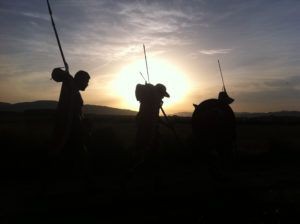
Indeed, the first objective of this project was carry out a scientific study of experimental archeology on the Republican legions in march. With this objective, the seven participants (all of them volunteers) who carried out the crossing, were characterized by the time as Roman legionnaires (centurion, veles , hastatus , princeps and triarius ) and as allied italic or auxiliary troops (Samnite and Iberian Laietan). During the fifteen days that the march lasted, numerous and interesting data could be collected both on the physical and personal level (heat wear, hydration, most frequent pathologies, injuries, etc.) and on the material level (wear of footwear, suspension systems shields, transport systems for baggage and weapons, setting up shops, etc.). All this information, which is currently in the process of being collected, structured, reviewed and studied, begins to provide some alternative perspectives on the Republican legions on the march. The final results will be published in congresses, specialized journals and general publications both in the scientific field and in historical re-enactment.
For now we can advance some hypotheses about the wear of footwear, an aspect greatly influenced by the excessive number of paved roads that we were forced to travel. Three types of footwear were put into practice:caligae type sandals with conical nails, with flat nails and carbatinae (closed leather shoes without studs). The result was that the number and severity of foot injuries were directly proportional to the size of the nails, with the participant using carbatinae the one who suffered the least. Evidently, the wear of the footwear was much lower in the case of the studded options, having to add them to the carbatinae new leather soles twice. At the level of the equipment suspension, we opted for the simplest solutions. The shield was arranged on the back like a backpack with two handles made of strips of wool. The stack / spears / soliferrea that each participant carried according to their role, leaned on the shield, tying their helmet or a bundle behind it, as a furca of imperial times. Finally, for the transport of liquids we decided to use skins and gourds. Putting both systems into practice, we verified how the second solution is much more suitable, due to its greater sealing properties and thermal conservation.
4.On your website you published a typical diet of the Roman soldier of the period. Were the Roman army's own diets and lodging also recreated? And, if so, what could you deduce from it?
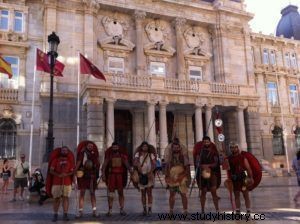
In effect, parallel to the march, He also recreated the food of the Roman legionnaires and their daily activities. The diet we adopt was specially designed for VIA SCIPIONIS by one of the group members based on the available written documentation. The base, of course, was the cereal, which we consumed above all in the form of bucellatum , an unleavened bread that does not deteriorate over time, but also in the form of porridge for dinner. This was complemented by plenty of nuts, fruit, vegetables, cheese and some meat, especially pork. The latter was the only item that we rationed extensively, with a maximum intake of 200 g per participant per day. All this was complemented by the fruits that we were able to collect on the go, such as figs, blackberries or carob beans, in a certain way honoring the classic quote by Cato the Elder:bellum se ipsum alet (war feeds itself). Liquid-wise, we drank both water and posca , a mixture of vinegared wine with water. Its consumption per participant was between 5 and 6 l on average, although on the hottest days we reached 8 l.
Each day, once the destination was reached, the legionnaires set up a proportional section of a military camp, with shops and historical furniture. Inside these tents, wicker mats were arranged and on them the sagum (or wool cape) that each participant carried with them. This piece of cloth constituted at the same time the sheet, the blanket when it was cold and even the pillow. Subsequently, there were a series of daily tasks that the different members of the conspiracy divided among themselves, such as the search for wood for the fire, the kitchen, the repair of the equipment (especially the footwear) and the cleaning of the belongings, the cures of feet or preparing for the next day of walking.
5.How much acceptance did the Via Scipionis project have in the towns you passed through? Were there followers or even volunteers who joined to travel those km with you?
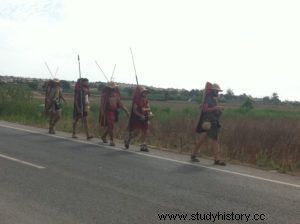
Another main objective of the VIA SCIPIONIS it was also to arouse the public's interest in their own patrimonial legacy through didactics and historical re-enactment. This discipline, known in the Anglo-Saxon world as «re-enactment», can be considered both an excellent cultural and educational tool and an excellent claim for quality tourism. Thus, upon arrival at the camping location, a talk was held for a couple of hours about the project, about the historical period and about the possibilities of this type of activity as elements of revitalization at a tourist, social and economic level. . This allowed the public to approach the past in a pleasant and direct way, breaking the barrier that usually separates it from the archaeological or literary vestige through the accessibility of replicas of pieces that are exhibited in a showcase in museums or mentioned in the sources. classics. The public was invited to learn what daily life was like for those men who conquered Cartagena in just one day, giving them the extraordinary opportunity to try the same food and drinks as the participants on the route, and therefore, the Roman legionnaires of the past. In total, this edition has been visited by more than a thousand people, a very considerable figure, especially if we take into account that it has not enjoyed optimal publicity.
In the future, the idea is that the VIA SCIPIONIS become a participatory event that allows not only to witness it as a spectator, but also to relive the march as one more member of the Roman army. In this sense, in this first edition we have already had the participation of two volunteers who joined us during a day of march. The organization provided them with the necessary equipment and they only had to contribute the desire and enthusiasm for the story.
In addition, it has raised the interest of several audiovisual media (TVE, RNE, Cadena Ser or COPE among others) and written press ("El Periódico de Cataluña", "Diario de Tarragona”, “El Punto” or “La Verdad” among others) in addition to dozens of blogs and social network users who have echoed the originality and value of the initiative. This interest also reached political representatives at both the local and regional levels and numerous councilors and mayors as well as cultural and heritage technicians received this proposal with open arms. Among them, it is necessary to highlight the presence of the Minister of Education, Research, Culture and Sports of the Generalitat Valenciana, Mr. Vicent Marzà, who was willing to discuss the institutional support of the Generalitat in future editions of the VIA SCIPIONIS . In this same sense, practically all the political representatives agreed and showed their predisposition to offer more support at all levels, from economic to organizational.
6.When the tour ended in Cartago, did you also recreate the siege?

No, it would have been awesome though! The truth is that the last day we were so tired that getting to Cartagena was already quite an achievement. In any case, the hero-worthy welcome we received from the City Council and the Federation of Troops and Legions at the Carthaginian and Roman festivities in the Roman theater was a more than welcome reward. In the same way, in many other municipalities and towns they received us in style, such as in Traiguera, where the Iberian leaders of Intibili they symbolically handed us the keys to the city, or in Sagunto, where the duomviros of the city waited for us at their gates and escorted us to the archaeological area of the Vía del Pórtico, where remains of the Via Augusta whose route we were following are still preserved .
In any case, the possibility of recreating a siege or a battle is a very interesting and attractive idea that we consider for future editions. In fact, several city councils and historical re-enactment groups have let us know of their interest in developing parallel activities of this type. Who knows if in future editions we will be able to see a recreation of the battle of Hibera? , disputed years before between Gnaeus Cornelio Scipio (uncle of "our" Scipio) and Asdrúbal Barca in a place between the Ebro and Traiguera, or the incredible sieges of Sagunto or Cartago Nova? In this sense, the possibility of extending the itinerary with the inauguration of a second section between Cartagena and Alcalá del Río in Seville (in commemoration of the battle of Ilipa which has traditionally been located there) or Cádiz (its surrender to Scipio represents the definitive end of the Punic presence in Iberia).
7.We would like to know your general impressions about the experience, both from a scientific and personal point of view.
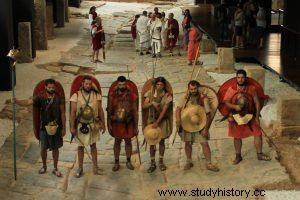
The general impression is that despite the harsh of the march (after the first day, we ourselves did not believe that this would be feasible), once the first three stages were over, our body adapted to the days and little by little we finished the stages earlier, we made fewer breaks and more short, and even water consumption decreased. Thus, the great limiter was not so much fatigue as the injuries that appeared, especially blisters, but also joint pain. Neither the diet nor the hardness of the ground when sleeping posed any problem, and we all quickly adapted to the "harshness" of military life. On the physical and physiological level, therefore, we were able to appreciate a remarkable adaptation to difficulties.
On a psychological or personal level, it was easy to “get under the skin” of the former legionnaires who often had to carry out these marches. Throughout the more than 30 km per day of march, we have had plenty of time for it and to reflect deeply on it. An example is that the rigor that is experienced in these marches allows us to suppose that they constituted a factor that brought great hardness to those men who, after having suffered the unspeakable in the march, would not be willing to sell their lives easily when presenting battle. . Rather the complete opposite. In a way, it can be speculated that the initial demoralization caused by hardship over time turned into the opposite feeling and mutated into a very positive state of mind.
8.Do you intend to undertake projects similar to Via Scipionis in the future?
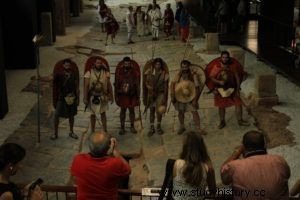
For future editions, in the development of which we are already working on, the implementation of new objects of experimental study is planned, as well as new activities and new informative topics, to expand both the scientific possibilities and the tourist attractions. Among the novelties, the possibility of expanding the group of participants to two contubernia is also being studied. (that is, 16 people plus two or three people in charge of logistics), with the participation of European re-enactors, or even the use of mules (each contubernium carried one) or carriages.
Finally, the VIA SCIPIONIS can be considered as the preface of another much more ambitious project called VÍA ANNIBALICA , which is currently under development. Its objective is to use the mass recreation of some of the most important events and battles carried out by Hannibal Barca at an international level, such as the passage of the Alps with elephants or the Battle of Cannae, and the participation of the highest academic authorities worldwide such as a scientific and tourist attraction throughout the countries that today house scenes of those events within their borders (Spain, France, Italy and Tunisia). The range of possibilities is very wide, and this is how the municipalities and scientific personalities who already support it have understood, although we still lack the definitive economic boost that we are trying to obtain from the European Union.
Where can you find them?
- On your website
- On your Facebook
- On his Twitter
